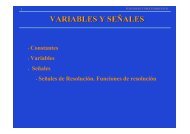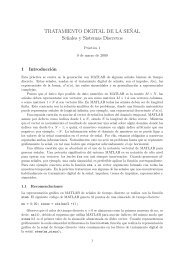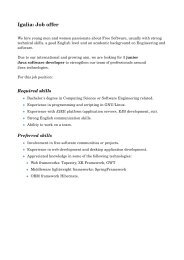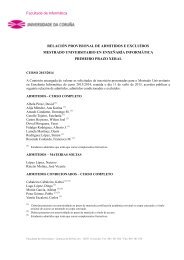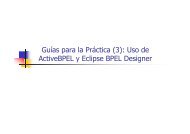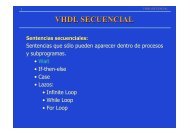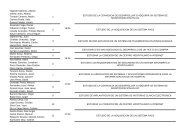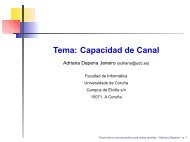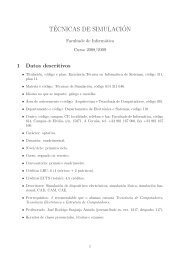- Page 1 and 2:
GUÍA DOCENTE ASIGNATURAS 2003-2004
- Page 3 and 4:
Estructura de Computadores II......
- Page 5 and 6:
FACULTADE DE INFORMÁTICA Curso aca
- Page 7 and 8:
Cálculo Descriptores ITIG Cuatrime
- Page 9 and 10:
Estructura de Datos y de la Informa
- Page 11 and 12:
Estadística I Descriptores ITIG
- Page 13 and 14:
Concepto de estimador puntual. La d
- Page 15 and 16:
o Proposiciones. Operaciones lógic
- Page 17 and 18:
financieras. 1ª ed. Civitas. 2000
- Page 19 and 20:
Programación Descriptores ITIG Cua
- Page 21 and 22:
• Operaciones sobre archivos •
- Page 23 and 24:
Contenido 1. Sistemas Digitales Com
- Page 25 and 26:
o Transistor unipolar 3. Circuitos
- Page 27 and 28:
Objetos. McGraw-Hill, 1998. Conteni
- Page 29 and 30:
5. Diseño lógico de Bases de Dato
- Page 31 and 32:
Matlab. Pirámide, 1999. Contenido
- Page 33 and 34:
ITIG Ingeniería del Software de Ge
- Page 35 and 36:
ITIG Metodología de la Programaci
- Page 37 and 38:
Programación Declarativa Descripto
- Page 39 and 40:
Sistemas Operativos I Descriptores
- Page 41 and 42:
Tecnología de la Programación Des
- Page 43 and 44:
Investigación Operativa Descriptor
- Page 45 and 46:
ITIG Principios de Análisis Inform
- Page 47 and 48:
Redes de Comunicaciones Descriptore
- Page 49 and 50:
Sistemas Operativos II Descriptores
- Page 51 and 52:
Álgebra Descriptores ITIS - Estruc
- Page 53 and 54:
Cálculo Descriptores ITIS Cuatrime
- Page 55 and 56:
Estructura de datos y de la informa
- Page 57 and 58:
Estadística I Descriptores ITIS -
- Page 59 and 60:
confianza para la diferencia de med
- Page 61 and 62:
1. Análisis vectorial. Capítulo I
- Page 63 and 64:
o Proposiciones. Operaciones lógic
- Page 65 and 66:
ALGORITMOS, PROGRAMAS Y LENGUAJES
- Page 67 and 68:
Tecnología de Computadores Descrip
- Page 69 and 70:
Tecnología Electrónica Descriptor
- Page 71 and 72:
Bases de Datos I Descriptores ITIS
- Page 73 and 74:
Matlab. Pirámide, 1999. Contenido
- Page 75 and 76:
o Rendimiento 2. El repertorio de i
- Page 77 and 78:
Wesley Iberoamericana, 1999. Conten
- Page 79 and 80:
los SOM. Propiedades de los SOM. Ej
- Page 81 and 82:
o Soluciones hardware y software al
- Page 83 and 84:
Identificadores libres y ligados. o
- Page 85 and 86:
Hall 2002. Contenido Parte I: Jerar
- Page 87 and 88:
Tema 4: Análisis de Fourier de se
- Page 89 and 90:
o ICMP y los protocolos básicos de
- Page 91 and 92:
o Creación y terminación de proce
- Page 93 and 94:
2. Lenguajes Regulares o Lenguajes
- Page 95 and 96:
Mathematica. Prensas Universitarias
- Page 97 and 98:
o Funciones continuas. Teorema de B
- Page 99 and 100:
o Listas con cabecera 3. Pilas o Pi
- Page 101 and 102:
2. Descripción estadística de var
- Page 103 and 104:
Contenido 1. Conceptos de inferenci
- Page 105 and 106:
2. Electrostática. Campo eléctric
- Page 107 and 108:
1. Introducción a la Lógica. o Pr
- Page 109 and 110:
Contenido ALGORITMOS, PROGRAMAS Y L
- Page 111 and 112:
II (Ciclo 1) Tecnología de computa
- Page 113 and 114:
Tecnología Electrónica Descriptor
- Page 115 and 116:
Algoritmos Descriptores II - Inducc
- Page 117 and 118:
Bases de Datos I Descriptores II -
- Page 119 and 120:
II Computación Numérica Cuatrimes
- Page 121 and 122:
II Estructura de Computadores I Cua
- Page 123 and 124:
Metodología de la Programación De
- Page 125 and 126:
Programación Declarativa Descripto
- Page 127 and 128:
Sistemas Conexionistas Descriptores
- Page 129 and 130:
Sistemas Operativos I Descriptores
- Page 131 and 132:
Tecnología de la programación Des
- Page 133 and 134:
Contenido PARTE I: Jerarquía de Me
- Page 135 and 136:
1. Conceptos de inferencia estadís
- Page 137 and 138:
• Solución gráfica de problemas
- Page 139 and 140:
Tema 4: Análisis de Fourier de se
- Page 141 and 142:
1. El protocolo IP, con una descrip
- Page 143 and 144:
o Creación y terminación de proce
- Page 145 and 146:
o Autómatas finitos deterministas.
- Page 147 and 148:
2. Paralelismo a nivel de instrucci
- Page 149 and 150:
Contenido 1. Introducción. o El m
- Page 151 and 152:
Ullman, J. y Widom, J. A first cour
- Page 153 and 154:
MÓDULO I - Conceptos básicos 1. I
- Page 155 and 156:
Page-Jones, M. The Practical Guide
- Page 157 and 158:
Borrajo, J. y Martínez y Pazos. In
- Page 159 and 160:
permutaciones, y combinaciones con
- Page 161 and 162:
Russel, S. y Norvig, P. Inteligenci
- Page 163 and 164:
IEEE Guide to Software Requirements
- Page 165 and 166:
2001. McLaughlin, B. Java and XML,
- Page 167 and 168:
Complementaria Tanenbaum. Redes de
- Page 169 and 170:
Análisis y Diseño Orientado a Obj
- Page 171 and 172:
II (Ciclo 2) - ITIG Arquitectura Cl
- Page 173 and 174:
Aspectos Jurídicos y Deontológico
- Page 175 and 176:
APARICIO SALOM, J., Estudio sobre l
- Page 177 and 178:
1. Nociones generales. 2. La Propie
- Page 179 and 180:
6. Nulidad y caducidad de la marca
- Page 181 and 182:
o Redundancia en tiempo. o Toleranc
- Page 183 and 184:
Tema 1 Introducción 1.1 Visión Ge
- Page 185 and 186:
Ullman, J.; Widom, J. A first cours
- Page 187 and 188:
3. Modelo de bases de datos deducti
- Page 189 and 190:
Evolución y cognición. Mente cons
- Page 191 and 192:
Comunicaciones Digitales Descriptor
- Page 193 and 194:
o Operaciones complementarias o Tra
- Page 195 and 196:
Gestión de Redes Descriptores - Ca
- Page 197 and 198:
PARTE V. PLATAFORMAS DE GESTIÓN DE
- Page 199 and 200:
o Introducción. o Características
- Page 201 and 202:
o Dibujo de curvas 3. Dibujo de obj
- Page 203 and 204:
Contenido TEMA 1. DIRECCIÓN Y GEST
- Page 205 and 206: 2. Instrumentación biomédica. 3.
- Page 207 and 208: Chapter 11: Information Systems Cha
- Page 209 and 210: Inteligencia Artificial Descriptore
- Page 211 and 212: 10. ANÁLISIS DE COSTES/BENEFICIOS
- Page 213 and 214: o Entrada o Salida o Sistemas de ve
- Page 215 and 216: a. Segmentación de textos b. Morfo
- Page 217 and 218: 2. Lógica de primer orden o Sintax
- Page 219 and 220: 3. Adaptación de las señales a lo
- Page 221 and 222: 1. Introducción. 2. Problemas de c
- Page 223 and 224: 1. Control de Calidad. Introducció
- Page 225 and 226: o Generación de números pseudo-al
- Page 227 and 228: 4. Microsoft Powerpoint o Introducc
- Page 229 and 230: • Revisión de las arquitecturas
- Page 231 and 232: Contenido 1. Arquitectura de ordena
- Page 233 and 234: 1992. P. Hudak, J. Peterson, J. Fas
- Page 235 and 236: Braude, Eric J. Software Engineerin
- Page 237 and 238: Internet como en Intranet. En concr
- Page 239 and 240: Bibliografía Recomendada Arbib, M.
- Page 241 and 242: 1. Introducción. Conceptos de sist
- Page 243 and 244: 2. Sensores y transductores • Car
- Page 245 and 246: Definición 1. Transformada de Lapl
- Page 247 and 248: Sistemas de tiempo real Descriptore
- Page 249 and 250: Sistemas expertos Descriptores •
- Page 251 and 252: Técnicas de simulación Descriptor
- Page 253 and 254: II (Ciclo 1) - ITIG Técnicas opera
- Page 255: Teoría de códigos Descriptores
- Page 259 and 260: II (Ciclo 1) - ITIS Tratamiento dig
- Page 261 and 262: Visión Arificial Descriptores II (
- Page 263 and 264: Teoría de Juegos Descriptores Libr



